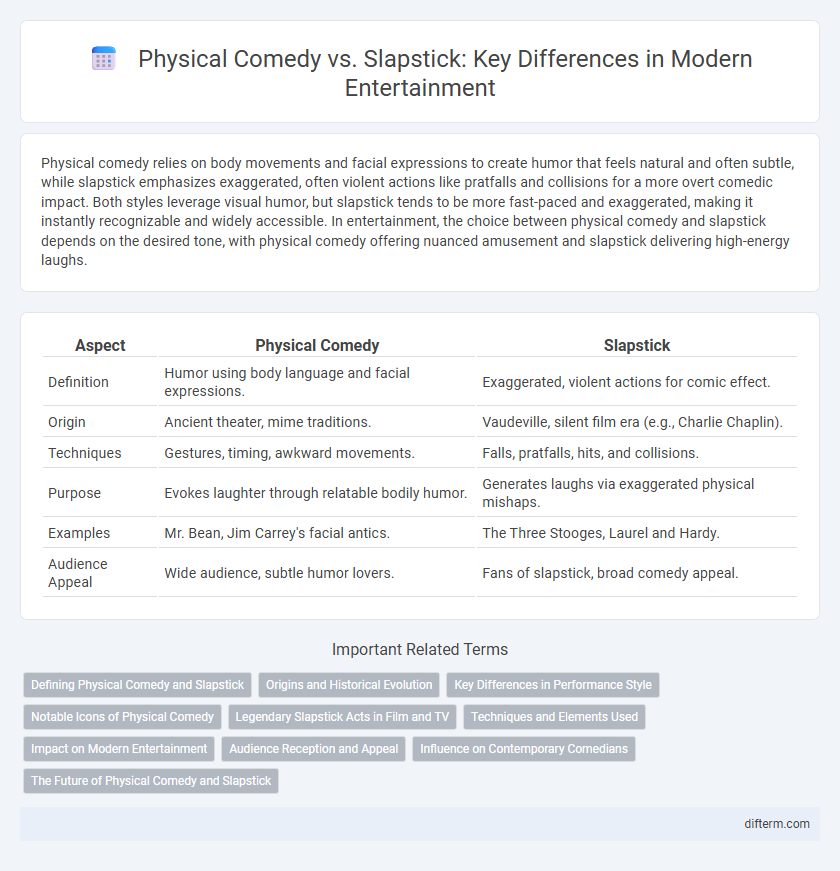Physical comedy relies on body movements and facial expressions to create humor that feels natural and often subtle, while slapstick emphasizes exaggerated, often violent actions like pratfalls and collisions for a more overt comedic impact. Both styles leverage visual humor, but slapstick tends to be more fast-paced and exaggerated, making it instantly recognizable and widely accessible. In entertainment, the choice between physical comedy and slapstick depends on the desired tone, with physical comedy offering nuanced amusement and slapstick delivering high-energy laughs.
Table of Comparison
| Aspect | Physical Comedy | Slapstick |
|---|---|---|
| Definition | Humor using body language and facial expressions. | Exaggerated, violent actions for comic effect. |
| Origin | Ancient theater, mime traditions. | Vaudeville, silent film era (e.g., Charlie Chaplin). |
| Techniques | Gestures, timing, awkward movements. | Falls, pratfalls, hits, and collisions. |
| Purpose | Evokes laughter through relatable bodily humor. | Generates laughs via exaggerated physical mishaps. |
| Examples | Mr. Bean, Jim Carrey's facial antics. | The Three Stooges, Laurel and Hardy. |
| Audience Appeal | Wide audience, subtle humor lovers. | Fans of slapstick, broad comedy appeal. |
Defining Physical Comedy and Slapstick
Physical comedy involves using body movements, gestures, and facial expressions to evoke laughter, emphasizing character interaction and timing over scripted dialogue. Slapstick is a subset of physical comedy characterized by exaggerated, often violent actions such as pratfalls, pie-throwing, and collisions designed for humorous effect. Both rely on visual humor, but slapstick prioritizes overt, high-impact physical gags while physical comedy encompasses a broader range of expressive bodily humor.
Origins and Historical Evolution
Physical comedy traces its origins to ancient theatrical traditions such as Greek Old Comedy and Roman mime, emphasizing exaggerated body movements and facial expressions to evoke humor. Slapstick evolved during the Italian Renaissance commedia dell'arte, characterized by its use of a wooden paddle (the "slap stick") to create loud, striking sound effects accompanying exaggerated physical antics. Over time, slapstick became central to silent films, with pioneers like Charlie Chaplin and Buster Keaton refining its broad, visual humor for mass audiences.
Key Differences in Performance Style
Physical comedy relies on exaggerated body movements and facial expressions to convey humor, emphasizing character-driven antics and situational awkwardness. Slapstick, a subgenre of physical comedy, centers on overt, often violent actions like falls, hits, and chases, using precise timing and choreographed sequences to elicit laughter. The key difference lies in slapstick's reliance on intentional, high-impact mishaps, while physical comedy encompasses a broader range of non-verbal humor through everyday physicality.
Notable Icons of Physical Comedy
Charlie Chaplin, Buster Keaton, and Rowan Atkinson stand as iconic figures in physical comedy, skillfully blending exaggerated gestures with subtle body language to evoke laughter. Their mastery of timing and expressive movement transcends language, making their performances universally relatable. While slapstick emphasizes overt, often violent humor through exaggerated stunts, the nuance in physical comedy allows these legends to engage audiences with a broader emotional spectrum and inventive storytelling.
Legendary Slapstick Acts in Film and TV
Legendary slapstick acts in film and TV, such as Charlie Chaplin's "The Tramp" and the chaotic antics of The Three Stooges, have defined physical comedy through exaggerated, often violent humor that relies on visual gags and precise timing. Unlike broader physical comedy, slapstick emphasizes pratfalls, pie-throwing, and over-the-top bodily mishaps to elicit laughter. These iconic performances helped shape the comedy genre, influencing modern comedians and films that continue to draw on slapstick's timeless appeal.
Techniques and Elements Used
Physical comedy relies on exaggerated body movements, facial expressions, and precise timing to create humor, often incorporating everyday actions with a humorous twist. Slapstick emphasizes exaggerated, often violent physical actions such as falls, collisions, and pratfalls, using props and choreographed stunts to generate laugh-out-loud moments. Key elements of slapstick include rapid escalation of mishaps and visual absurdity, while physical comedy focuses more on subtlety and character-driven gestures.
Impact on Modern Entertainment
Physical comedy and slapstick have profoundly shaped modern entertainment by influencing comedic timing, visual humor, and character-driven gags across film, television, and digital media. Icons like Charlie Chaplin and Buster Keaton pioneered techniques that emphasize exaggerated movement and physicality, which remain integral in contemporary comedy genres and viral video formats. The enduring popularity of physical comedy and slapstick highlights their role in transcending language barriers, making humor accessible and impactful worldwide.
Audience Reception and Appeal
Physical comedy leverages body language and exaggerated movements to create humor, appealing broadly due to its relatable and universal nature, while slapstick relies heavily on exaggerated, often violent actions like pratfalls and collisions for laughs. Audience reception favors physical comedy for its subtlety and adaptability across cultures, whereas slapstick attracts those who enjoy overt, visceral humor with clear cause-and-effect gags. Both forms remain pillars of entertainment, with physical comedy often perceived as more sophisticated and slapstick praised for its high-energy spectacle.
Influence on Contemporary Comedians
Physical comedy and slapstick have profoundly shaped contemporary comedians by emphasizing exaggerated movements and visual humor that resonate with diverse audiences. Icons like Rowan Atkinson and Jim Carrey incorporate slapstick's energetic antics combined with physical comedy's nuanced expressions to create memorable performances. This fusion enhances comedic timing and broadens entertainment appeal in modern stand-up, film, and television comedy.
The Future of Physical Comedy and Slapstick
The future of physical comedy and slapstick lies in blending traditional exaggerated movements with modern technology, such as virtual reality and motion capture, enhancing audience immersion and interactivity. Emerging comedians are innovating by integrating physical humor with multimedia elements, expanding the genres' appeal across digital platforms and global markets. As entertainment consumption shifts towards streaming and interactive content, physical comedy and slapstick will evolve to maintain their relevance while preserving their classic appeal.
Physical Comedy vs Slapstick Infographic

 difterm.com
difterm.com